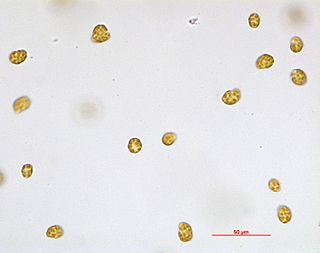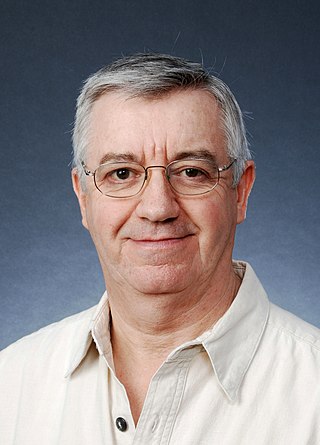
An algal bloom or algae bloom is a rapid increase or accumulation in the population of algae in freshwater or marine water systems. It is often recognized by the discoloration in the water from the algae's pigments. The term algae encompasses many types of aquatic photosynthetic organisms, both macroscopic multicellular organisms like seaweed and microscopic unicellular organisms like cyanobacteria. Algal bloom commonly refers to the rapid growth of microscopic unicellular algae, not macroscopic algae. An example of a macroscopic algal bloom is a kelp forest.

Ramon Margalef i López was a Spanish biologist and ecologist. He was Emeritus Professor of Ecology at the Faculty of Biology of the University of Barcelona. Margalef, one of the most prominent scientists that Spain has produced, worked at the Institute of Applied Biology (1946–1951), and at the Fisheries Research Institute, which he directed during 1966-1967. He created the Department of Ecology of the University of Barcelona, from where he trained a huge number of ecologists, limnologists and oceanographers. In 1967 he became Spain's first professor of ecology.

Sallie Watson "Penny" Chisholm is an American biological oceanographer at the Massachusetts Institute of Technology. She is an expert in the ecology and evolution of ocean microbes. Her research focuses particularly on the most abundant marine phytoplankton, Prochlorococcus, that she discovered in the 1980s with Rob Olson and other collaborators. She has a TED talk about their discovery and importance called "The tiny creature that secretly powers the planet".

Heterosigma akashiwo is a species of microscopic algae of the class Raphidophyceae. It is a swimming marine alga that episodically forms toxic surface aggregations known as harmful algal bloom. The species name akashiwo is from the Japanese for "red tide".
The Ramon Margalef Prize in Ecology is a prize awarded annually by the Generalitat de Catalunya to recognize an exceptional scientific career or discovery in the field of ecology or other environmental sciences. The award was created to honor the life and work of Ramon Margalef. The award has been presented every year since 2004 and comes with an honorarium of €80,000 and a sculpture representing a microalga, called Picarola margalefii. It is open to ecologists from anywhere in the world.

The Australian Continuous Plankton Recorder (AusCPR) survey is a joint project of the CSIRO and the Australian Antarctic Division, DEWHA, to monitor plankton communities as a guide to the health of Australia's oceans.
The Centre for Marine Living Resources & Ecology (CMLRE) is a research institute in Kochi, Kerala under the Ministry of Earth Sciences, Government of India with a mandate to study the marine living resources. Today, apart from implementing various research projects of the ministry, the institute also manages and operates the Fishery Oceanographic Research Vessel (FORV) Sagar Sampada.

Cochlodinium polykrikoides is a species of red tide producing marine dinoflagellates known for causing fish kills around the world, and well known for fish kills in marine waters of Southeast Asia. C. polykrikoides has a wide geographic range, including North America, Central America, Western India, Southwestern Europe and Eastern Asia. Single cells of this species are ovoidal in shape, 30-50μm in length and 25-30μm in width.

Scientia Marina, formerly Investigación Pesquera, is a peer-reviewed academic journal on marine research published by Institut de Ciències del Mar de Barcelona (CSIC) since 1955. The journal is abstracted and indexed in the Science Citation Index, Current Contents/Agriculture, Biology and Environmental Sciences, Biosis, Food Science & Technology Abstracts, GEOBASE, DIALNET, and Scopus. According to the Journal Citation Reports, the journal has a 2020 impact factor of 1.576, ranking it 67th out of 110 journals in the category "Q3, Marine and Freshwater Research".

Josefina Castellví Piulachs is a Spanish oceanographer, biologist and writer. Castellvi Peak on Hurd Peninsula, on Livingston Island in Antarctica is named in her honour. In 1984 she was the first Spaniard to participate in an international expedition to Antarctica. She received her bachelor's degree in 1957 and a PhD in biological sciences at the University of Barcelona in 1969. In 1960 she started working for the Institut de Ciències del Mar in Barcelona. In addition, she conducted research at the Spanish National Research Council (CSIC) and was a delegate in Catalonia for two years (1984-1986).
Susana Agustí Requena is a Spanish biological oceanographer who has participated in over 25 oceanographic expeditions in the Arctic, Southern Ocean (Antarctic), Atlantic, Pacific and Indian Oceans. She played a key role in the Malaspina Circumnavigation Expedition. She is professor in Marine Science at King Abdullah University of Science and Technology in Saudi Arabia and an adjunct Professor at the University of Tromsø (Norway).

Joan Antoni Solans i Huguet was a Spanish Catalan architect who focused his career on urban planning.
Collin Roesler is an American oceanographer. She is known for her work on optical oceanography, including research on harmful algal blooms in the Gulf of Maine and green icebergs.

Trevor Charles Platt was a British and Canadian biological oceanographer who was distinguished for his fundamental contributions to quantifying primary production by phytoplankton at various scales of space and time in the ocean.
Patricia Marguerite Glibert is marine scientist known for her research on nutrient use by phytoplankton and harmful algal blooms in Chesapeake Bay. She is an elected fellow of the American Association for the Advancement of Science.
Ana María Gayoso was an Argentine marine biologist, a specialist in study of marine phytoplankton, best known for being the first scientist to describe phytoplankton in the Bahía Blanca Estuary, and to initiate the sustained long-term oceanographic dataset in this ecosystem. She made significant contributions to the understanding of harmful algal blooms caused by toxic dinoflagellate species in the Patagonian gulfs, and was the first scientist to describe high abundances of the coccolithophore Emiliania huxleyi in the Argentine Sea, a key component in the primary productivity along the Patagonian Shelf Break front in the SW South Atlantic. She started the most extensive (1978-present) long-term database of phytoplankton and physico-chemical variables in South America, in a fixed monitoring site in the Bahía Blanca Estuary. She died on 28 December 2004 in Puerto Madryn.
Colleen Beckmann Mouw is an associate professor at the University of Rhode Island known for her work on phytoplankton ecology and increasing retention of women in oceanography.
Evelyn Lessard is a biological oceanographer and a professor at the University of Washington's School of Oceanography.
Margaret Ruth Mulholland is professor at Old Dominion University known for her work on nutrients in marine and estuarine environments.

Pilar González i Duarte is a Spanish chemist. She is a member of the Institute for Catalan Studies (IEC). In 2004, she was the recipient of the Jaume Vicens i Vives distinction awarded by the Government of Catalonia.











